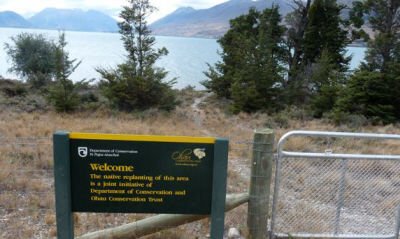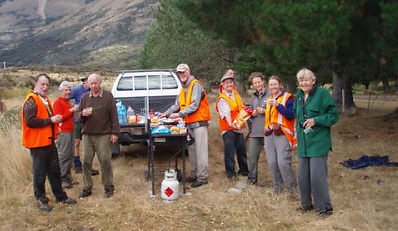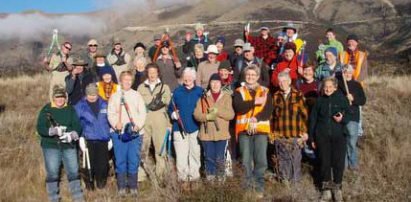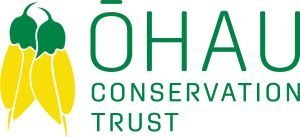2010/11 has seen tremendous progress in conservation work around Lake Ōhau. $7,000 has been spent by the Trust on contractors to remove wild rose-briar, broom, barberry and other weeds along the lake shore. This work is being followed up by Trust volunteers. The scrub cutter bought with grant funding from Meridian Energy has proved extremely useful.
Wilding conifer removal in recent months has seen the greatest progress in the Trust’s seven-year existence. Volunteers have worked in excess of 2,000 hours over the past year, with the result that the tussock terraces above the lake between Parsons Creek and the Lake Ōhau Lodge almost up to the ski field road are now 95 percent free of wildings. Although some new seedlings will appear for the next few years, the mature pinus contorta that are the seed sources are being removed, and this problem will be vastly reduced in future. The unstinting support of the owners of the Lake Ōhau Lodge and Snow Fields and many of their staff has contributed enormously to this success.
Progress has also been made on private land adjoining the Freehold Creek conservation land. In autumn the landowner and friends were joined by Trust supporters, Department of Conservation contractors and a team from the Forest & Bird Society Dunedin Branch’s Wilding Pine Group wielding chainsaws and scrub cutters. A range of processes were employed on larger trees, some of which were chain-sawn and the stumps poisoned, others cut low to the ground and the remaining bark stripped. It will be interesting to compare the effectiveness of different control methods in a few months time.
On what can be thought of as the positive side of activities, the bulk of the Community Conservation Fund’s nearly 2,000 locally-sourced seedlings have been planted along the lake shore over the last two years. Many of these are berry-producing plants chosen specifically to attract birds, but along the roadsides and walking tracks, attractive flowering hebes and trees such as kowhais and beech are also being established, along with a variety of tussocks. Last year’s wet, warm summer has ensured that a good 95 per cent of the first swathe of plantings have survived and indeed are thriving. This year’s seedlings are now all in the ground.
The Ōhau Conservation Trust was recently awarded this year’s Canterbury Aoraki Conservation Board Award for conservation activities, presented by Minister of Conservation Kate Wilkinson to Trust representatives Hamish and Mike Darling in Rangiora at the end of September. All the above has been very heartening for the Trust as we wind down after what has undoubtedly been our most successful year to date.
The last three mild years have brought about a phenomenal germination and growth of self-seeded conifers. We’re not going to run out of targets for workdays any time soon! However, the Trust is encouraged as the old station plantations further up the valley that have been the seed source for “wildings” are being eliminated. The six years of the Trust’s existence have proved that the natural values of the Ōhau valley are not past the point of being rescued.

An attractive Department of Conservation sign has been put up by the gate into the lakeside reserve across the road from the Lake Ōhau Alpine Village. This indicates that revegetation of the fenced area is a joint project between DOC and the Ōhau Conservation Trust. Weed control in this area is continuing and beginning to show results, as is planting of beech, kowhai and tussocks. Plantings are thriving despite a very dry late summer and autumn.

BBQ lunch on the Avoca Flats, Lake Ohau, on 21 March 2010 with some of the Trust’s enthusiastic volunteers. From left: Malcolm McMillan (Lake Ōhau), Alison Aanensen (Taupo), Andy Aanensen [obscured], David Becroft (Auckland), John Smithies (Lake Ōhau) attending the barbecue, Eileen McMillan (Lake Ōhau), Matt Sole (Central Otago, obscured), Ursula Paul (DOC, Twizel), Anne Steven (Wanaka), Genevieve Becroft (Auckland).
Photo Alison Smithies.

